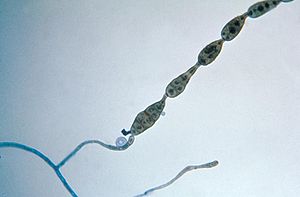- Pleosporales
-
Pleosporales 
Konidienkette eines Alternaria-Pilzes
Systematik Reich: Pilze (Fungi) Abteilung: Schlauchpilze (Ascomycota) Unterabteilung: Echte Schlauchpilze (Pezizomycotina) Klasse: Dothideomycetes Unterklasse: Pleosporomycetidae Ordnung: Pleosporales Wissenschaftlicher Name der Unterklasse Pleosporomycetidae Schoch, Spatafora, Crous & Shoemaker Wissenschaftlicher Name der Ordnung Pleosporales Luttrell ex M. E. Barr Die Pleosporales sind eine Ordnung der Schlauchpilze, die eine eigene Unterklasse Pleosporomycetidae bilden.
Inhaltsverzeichnis
Merkmale
Der Fruchtkörper ist ein Perithecium, Hysterothecium oder Kleistothecium. Die Form ist dabei sehr variabel. Der sterile Teil (Hamathecium) besteht aus Paraphysen. Die Asci besitzen eine zweischichtige Zellwand (bitunicat). Die Ascosporen sind bezüglich Farbe, Form und Septierung sehr variabel.[1]
Systematik
Die Pleosporales sind die artenreichste Ordnung in der Klasse der Dothideomycetes.
Eriksson (2006) führt 13 Familien in der Ordnung:[2]
- Delitschiaceae mit 3 Gattungen
- Lophiostomataceae mit 12 Gattungen, zum Beispiel
- Herpotrichia
- Massariaceae mit 6 Gattungen
- Massarinaceae mit 3 Gattungen
- Melanommataceae mit 18 Gattungen
- Montagnulaceae mit 4 Gattungen
- Phaeosphaeriaceae mit 22 Gattungen, zum Beispiel
- Phaeosphaeria
- Leptosphaeria
- Phaeotrichaceae mit 3 Gattungen
- Pleomassariaceae mit 5 Gattungen
- Silberschorf (Helminthosporium solani)
- Pleosporaceae mit 17 Gattungen, zum Beispiel
- Cochliobolus
- Lewia, Anamorphe Alternaria
- Sporormiaceae mit 8 Gattungen
- Teichosporaceae mit 8 Gattungen
- Venturiaceae mit 28 Gattungen
- Apfelschorf (Venturia inaequalis)
Bedeutung
Die Ordnung enthält einige wirtschaftliche bedeutende Pflanzen-Pathogene: Cochliobolus heterostrophus verursacht die Bleiche von Mais, Leptosphaeria maculans befällt Raps-Samen, Phaeosphaeria nodorum befällt Getreide.[1]
Einzelnachweise
- ↑ a b Schoch et al.: A multigene phylogeny of the Dothideomycetes using four nuclear loci, 2006.
- ↑ O. E. Eriksson (Hrsg.): Outline of Ascomycota - 2006 In: Myconet, Band 12, 2006, S. 1-82. (online html)
Literatur
- Conrad L. Schoch, Robert A. Shoemaker, Keith A. Seifert, Sarah Hambleton, Joseph W. Spatafora & Pedro W. Crous: A multigene phylogeny of the Dothideomycetes using four nuclear loci. In: Mycologia, Band 98, 2006, S. 1041-1052. (online)
Weblinks
Wikimedia Foundation.
